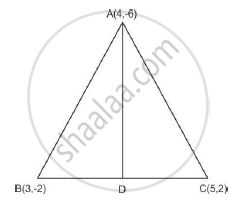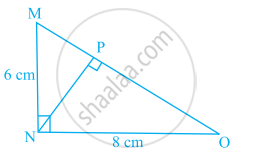Advertisements
Advertisements
प्रश्न
A(4, - 6), B(3,- 2) and C(5, 2) are the vertices of a 8 ABC and AD is its median. Prove that the median AD divides Δ ABC into two triangles of equal areas.
उत्तर
Solution:
Let the co-ordinates of D be D (x,y) and D is midpoint of BC
x = (3+5)/2 = 4; y = (2-2)/2 = 0

Now Area of triangle ABD = `1/2 [4(-2-0) +3(0+6)+4(-6+2)]` = `3 `
and Area of triangle ACD `=1/2 [5(-6-0) + 4(0 - 2) + 4(2+6)] = 3 `
Hence, the median AD divides triangle ABC into two triangle of equal area.
APPEARS IN
संबंधित प्रश्न
If A(−4, 8), B(−3, −4), C(0, −5) and D(5, 6) are the vertices of a quadrilateral ABCD, find its area.
For what value of k are the points (k, 2 – 2k), (–k + 1, 2k) and (–4 – k, 6 – 2k) are collinear ?
Find equation of line joining (1, 2) and (3, 6) using the determinant.
Find the area of the following triangle:

Find the centroid of ΔABC whose vertices are A(-1, 0) B(5, -2) and C(8,2)
Show that the following points are collinear:
(i) A(2,-2), B(-3, 8) and C(-1, 4)
Show that the following points are collinear:
A(-5,1), B(5, 5) and C(10, 7)
The area of the triangle whose vertices are A(1, 2), B(-2, 3) and C(-3, -4) is ______.
The points A(2, 9), B(a, 5) and C(5, 5) are the vertices of a triangle ABC right angled at B. Find the values of a and hence the area of ∆ABC.
In the given figure, ΔMNO is a right-angled triangle. Its legs are 6 cm and 8 cm long. Length of perpendicular NP on the side MO is ______.

